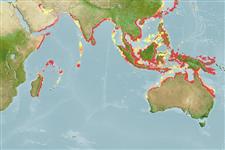分类 / Names
俗名 | 同种异名 | Catalog of Fishes(属, 种) | ITIS | CoL | WoRMS | Cloffa
Teleostei >
Carangaria/misc (Various families in series Carangaria) >
Polynemidae (Threadfins)
Etymology: Eleutheronema: Greek, eleutheros = free + Greek, nema = filament (Ref. 45335).
More on author: Shaw.
Environment: milieu / climate zone / depth range / distribution range
生态学
海洋; 淡水; 半咸淡水; 非产卵性溯降河的 (Ref. 51243); 深度上下限 0 - 23 m (Ref. 6390). 热带; 32°N - 26°S, 47°E - 154°E (Ref. 57343)
Indo-Pacific: Persian/Arabian Gulf, Pakistan, India and Sri Lanka (except the Red Sea and East Africa) to northern Australia and New Guinea. Replaced by Eleutheronema rhadinum (Jordan & Evermann, 1902), in East Asia (Japan, China, Viet Nam) (Ref. 41639).
印度-西太平洋: 波斯湾到巴布亚新几内亚与澳洲北部。 在亚洲东部 (日本,中国 , 越南) 被 Eleutheronema tetradactylum 取代了。
Length at first maturity / 大小 / 重量 / 年龄
Maturity: Lm ?, range 29 - ? cm
Max length : 200 cm TL 雄鱼/尚未辨别雌雄; (Ref. 3479); common length : 50.0 cm TL 雄鱼/尚未辨别雌雄; (Ref. 3479); 最大体重: 145.0 kg (Ref. 4965)
背棘 (总数) : 9; 背的软条 (总数) : 13 - 15; 臀棘: 3; 臀鳍软条: 14 - 16; 脊椎骨: 25. This species is distinguished with the following characters: second dorsal fin soft rays 14 (rarely 13 or 15) pectoral fin rays 16-18 (mode 17, rarely 15 or 19), pectoral filaments 4; pored
lateral line scales 71-80 (mode 73); scale rows above lateral line 9-12, below 13-15 (14); vomer with deciduous tooth plates on both sides, except in juveniles (< ca. 7.0 cm SL); posterior part of maxilla deep, 3-4% of SL; short tooth plate extension onto lateral surface of lower jaw, 7-9% SL. Colour of upper sides of head and trunk with slight darkish silver tinge, becoming lighter in lower sides; anterior margins of first and second dorsal fins blackish, remaining parts translucent and slightly blackish, respectively; pectoral fin membranes vivid yellow in life, except in large specimens > ca 35 cm SL which is dusky yellow; pectoral filaments white; anterior margin of pelvic fin yellow and other parts white; base of caudal fin yellowish, other parts blackish (Ref. 41639, 57343).
胸的丝状突起 4; 鳍薄膜生动的黄色活着时, 在大的个体中除,> ca 35 公分 SL。 在两边上犁骨有易脱落的齿板, 除了稚鱼。 颚骨的较后面的部分深的,3-4% 的 SL。 短齿碟延伸到下颌侧面。 7-9% SL.(参考文献 41639)
Adults occur mainly over shallow muddy bottoms in coastal waters. Also enter rivers (Ref. 3479, 6390, 11230). Juveniles found in estuaries. During winter, adults ascend the rivers. They usually form loose schools, although larger fish are more often observed in pairs or singly (Ref. 6390). Feed on prawns and fish (largely members of Mugilidae, Engraulidae, and Sciaenidae) with occasional polychaetes. Frequency of crustaceans to fish in the diet varies seasonally. Larvae (7-30 mm TL) feed mainly on copepods and mysids but also take shrimps and prawn larvae (Ref. 57343). Juveniles (31-60 TL) feed on prawns shrimps and mysids (Ref. 57343). Protandrous hermaphrodites. Marketed fresh, frozen, and dried or salted.
在沿岸水域中主要地遍及泥泞的浅水底部出现。 也进入河。 (参考文献 3479,11230) 稚鱼发现于河口了。 在冬天期间,成鱼上溯到河。 他们通常形成松散的鱼群, 虽然较大的鱼更时常被成对或各别地观察。 (参考文献 6390) 捕食虾,而且鱼 (主要地鲻科鱼类,鳀科与石首鱼科的成员) 偶而有多毛类动物。 对在食性中的鱼甲壳动物的频率季节性地改变。 仔鱼 (7-30 mm TL) 主要捕食桡脚类的动物,而且糠虾但也吃虾与虾类幼生。 (参考文献 57343) 稚鱼 (31-60 TL) 吃虾蝦與糠蝦。 (參考文獻 57343) 雄性先熟的雌雄同體。 在市場上銷售生鮮地了, 冷凍, 與乾燥或鹽醃。
Life cycle and mating behavior
成熟度 | 繁殖 | 产卵场 | 卵 | 孕卵数 | 仔鱼
In Australia, fish are males at 24-47 cm FL, hermaphrodites at 25-46 cm FL and females at 28-72 cm FL. On the northeast Queensland coast, most blue threadfin are females by 45-50 cm FL. Hermaphroditic blue threadfin develop fom 1-2-year-old fish, and females first appear as 2-3-year-old individuals (Ref. 28736). Male fish probably commence sex reversal immediately after spawning (ie about April-May) and this condition may persist until after the next spawning period (Ref. 28736). The progression from hermaphrodites to females is complete by the following season.
There is little information on the larvae, although nursery areas are known to be lower estuaries, tidal swamps and lagoons, and shallows along the foreshores (Williams 1997).印度-西太平洋: 波斯湾到巴布亚新几内亚与澳洲北部。 在亚洲东部 (日本,中国 , 越南) 被 Eleutheronema tetradactylum 取代了。
Motomura, H., Y. Iwatsuki, S. Kimura and T. Yoshino, 2002. Revision of the Indo-West Pacific polynemid fish genus Eleutheronema (Teleostei: Perciformes). Ichthyol. Res. 49(1):47-61. (Ref. 41639)
世界自然保护联盟红皮书 (Ref. 130435: Version 2024-2)
人类利用
渔业: 高经济性; 养殖: 商业性
工具
特别资料
下载 XML
网络资源
Estimates based on models
Preferred temperature (Ref.
123201): 25.2 - 29.3, mean 28.6 °C (based on 2815 cells).
Phylogenetic diversity index (Ref.
82804): PD
50 = 0.6250 [Uniqueness, from 0.5 = low to 2.0 = high].
Bayesian length-weight: a=0.00617 (0.00399 - 0.00953), b=3.06 (2.93 - 3.19), in cm total length, based on LWR estimates for this species & (Sub)family-body (Ref.
93245).
营养阶层 (Ref.
69278): 4.1 ±0.5 se; based on diet studies.
回复力 (Ref.
120179): 中等的, 族群倍增时间最少 1.4 - 4.4年 (Fec=680,000; assuming tm>=2).
Prior r = 0.56, 95% CL = 0.37 - 0.84, Based on 2 data-limited stock assessments.
Fishing Vulnerability (Ref.
59153): Very high vulnerability (90 of 100).
Climate Vulnerability (Ref.
125649): Very high vulnerability (91 of 100).
Nutrients (Ref.
124155): Calcium = 38.1 [12.5, 117.4] mg/100g; Iron = 0.744 [0.292, 1.866] mg/100g; Protein = 20 [18, 22] %; Omega3 = 0.122 [0.065, 0.224] g/100g; Selenium = 52.9 [18.1, 162.0] μg/100g; VitaminA = 15.1 [5.7, 40.9] μg/100g; Zinc = 0.92 [0.46, 1.74] mg/100g (wet weight); based on
nutrient studies.
